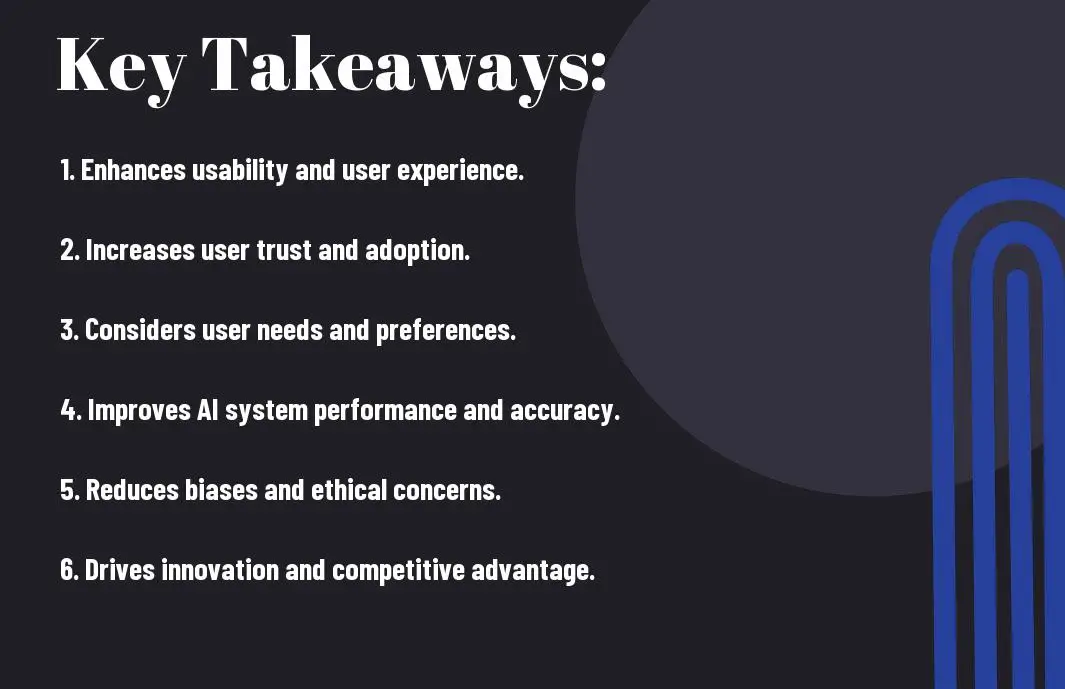User-Centered design lies at the heart of creating AI technology that truly benefits and empowers individuals. In the fast-evolving landscape of artificial intelligence, the focus on putting users first is not just a mere concept but a crucial element. This blog post investigates into the significance of incorporating user needs and feedback into AI development, highlighting how user-centered design can lead to more intuitive, ethical, and effective AI systems that truly resonate with people.
Key Takeaways:
- User Empathy: Incorporating user-centered design in AI technology is vital as it puts the focus on understanding the needs, behaviors, and preferences of the end user.
- Enhanced User Experience: By prioritizing user-centered design, AI technology can deliver interfaces that are intuitive, user-friendly, and tailored to meet the users’ expectations, ultimately leading to a more positive user experience.
- Increased Adoption and Success: Implementing user-centered design principles in AI technology can result in higher adoption rates, as users are more likely to engage with and trust technology that resonates with their needs and offers a seamless experience.
The Rise of AI Technology
Before we examine into the importance of user-centered design in AI technology, let’s take a moment to appreciate the rapid advancements in artificial intelligence in recent years. AI has evolved from being a concept of science fiction to a prevalent part of our daily lives, revolutionizing industries, services, and even personal interactions.
The Increasing Presence of AI in Daily Life
Increasing at an exponential rate, AI is now integrated into various aspects of our daily routines, from virtual assistants like Siri and Alexa to personalized recommendations on streaming platforms like Netflix and Spotify. Machine learning algorithms power our social media feeds, predict our online shopping preferences, and even assist in medical diagnoses. The convenience and efficiency that AI brings have made it indispensable in our modern world.
The Need for Human-Centric Approach
One of the critical aspects to consider amidst the proliferation of AI is the necessity for a human-centric approach. While AI systems are adept at processing and analyzing vast amounts of data, they often lack the ability to understand human emotions, intentions, and nuances. As AI technology becomes more ingrained in society, the focus must shift towards designing systems that prioritize user experiences and well-being.
Daily interactions with AI, ranging from chatbots to recommendation systems, highlight the importance of ensuring that these technologies are not only efficient but also user-friendly and ethically sound. By prioritizing the human element in the design and development of AI systems, we can create technology that truly enhances our lives while respecting our values and preferences.

The Limitations of Traditional Design Approaches
The Pitfalls of Technocentric Design
Assuming that technology is the central focus, designers may fall into the trap of technocentric design. This approach prioritizes the capabilities of the technology over the needs and preferences of the end users. When designers solely concentrate on what the AI technology can do without considering how users will interact with it, the result is often a product that fails to meet user expectations and needs.
The Consequences of Ignoring Human Factors
On the other hand, disregarding human factors in design can lead to serious consequences. User-centered design emphasizes the importance of understanding the behaviors, preferences, and limitations of the end users. Ignoring these crucial aspects can result in AI technologies that are difficult to use, leading to frustration, errors, and ultimately, user abandonment.
- Difficult to use AI technologies
- Frustration, errors, and user abandonment
Knowing and prioritizing the needs of users throughout the design process is important to creating AI technologies that are intuitive, effective, and ultimately successful.
The Principles of User-Centered Design
Empathy and User Research
After all, the cornerstone of user-centered design is empathy. Understanding the needs, behaviors, and preferences of the end-users is crucial in designing AI technology that truly enhances their lives. Conducting user research allows designers to step into the shoes of the users, gaining insights that drive thoughtful and impactful design decisions.
Co-Design and Collaboration
On the path to creating user-centric AI technology, co-design and collaboration play a pivotal role. Involving end-users in the design process fosters a sense of ownership and ensures that the final product meets their expectations and needs. Collaborating with diverse stakeholders brings together a wealth of perspectives, leading to more innovative and inclusive solutions.
User involvement in the co-design process goes beyond simply gathering feedback. It empowers users to actively participate in shaping the technology, making it more reflective of their realities and context.
Iteration and Feedback Loops
To enhance the user experience continuously, designers must embrace iteration and feedback loops. By collecting feedback from users and iterating on design solutions, technology can evolve to better meet the ever-changing needs and expectations of its users.
Design is an ongoing process, and feedback loops ensure that AI technology remains adaptive and responsive to user input, leading to more impactful and user-friendly solutions.
The Benefits of User-Centered Design in AI
Improved User Experience and Adoption
Designing AI technology with a user-centered approach leads to improved user experience and increased adoption rates. When users’ needs, preferences, and pain points are at the forefront of the design process, the resulting AI solutions are more intuitive, user-friendly, and relevant to their daily lives. This, in turn, fosters a positive user experience, making users more likely to embrace and engage with the technology.
Enhanced Trust and Transparency
Enhanced trust and transparency are crucial outcomes of incorporating user-centered design in AI technology. By involving users in the design process and being transparent about how AI algorithms work and make decisions, trust between users and AI systems is established and strengthened. Users are more likely to feel comfortable and confident interacting with AI technologies when they understand how their data is being used and how the technology operates.
To maintain trust and transparency, it is imperative for AI developers to prioritize user privacy, security, and ethical considerations throughout the design and implementation stages.
Better Decision-Making and Outcomes
Any AI technology is only as effective as the decisions it helps users make. By focusing on user-centered design, AI solutions can empower users to make better-informed decisions, leading to improved outcomes. When AI tools align with users’ goals, values, and cognitive processes, they can provide valuable insights and recommendations that enhance decision-making processes in various domains.
For instance, in healthcare, user-centered AI design can help healthcare professionals analyze patient data more effectively, leading to more accurate diagnoses and personalized treatment plans, ultimately improving patient outcomes.

Overcoming Challenges in Implementing User-Centered Design
Once again, the implementation of user-centered design in AI technology faces several challenges that need to be addressed for successful integration. From integrating design into AI development cycles to addressing ethical and moral considerations, these obstacles require careful navigation.
Integrating Design into AI Development Cycles
Design integration into AI development cycles is crucial for ensuring that the end product is user-friendly and meets the needs of its users. This process involves incorporating design thinking into each stage of AI development, from ideation to deployment, to create a seamless user experience.
Addressing Ethical and Moral Considerations
Design decisions in AI technology should also prioritize ethical and moral considerations to ensure that the technology aligns with societal values and norms. This involves contemplating the implications of AI algorithms on privacy, bias, and overall societal well-being.
As AI technology becomes more prevalent in our daily lives, it is important to consider the ethical and moral implications of its design and implementation. Ensuring that AI technologies are developed and used ethically is crucial for building trust with users and maintaining the benefits that AI can bring to society.
Balancing Human and Machine Capabilities
Ethical considerations in AI technology also involve balancing human and machine capabilities to create a symbiotic relationship where each complements the other’s strengths. This requires designing AI systems that enhance human decision-making rather than replacing it entirely.
Cycles of feedback and iteration are necessary to strike the right balance between human judgement and machine automation in AI technology. This continuous process allows for adjustments that prioritize the user experience while leveraging the capabilities of AI technology.
Real-World Applications of User-Centered Design in AI
Healthcare and Personalized Medicine
User-Centered design in AI has revolutionized healthcare by allowing for personalized medicine tailored to individual patients. By integrating AI algorithms that analyze vast amounts of data, healthcare professionals can make more accurate diagnoses and treatment plans. This level of customization ensures that patients receive the most effective care based on their unique genetic makeup, medical history, and lifestyle choices.
Education and Adaptive Learning
Design plays a crucial role in the development of AI technology for education, particularly in the area of adaptive learning. User-centered design principles enable platforms to adapt to students’ individual learning styles and paces, enhancing the overall learning experience. By utilizing AI algorithms to track student progress, identify strengths and weaknesses, and provide targeted feedback, educators can create personalized learning paths that cater to each student’s needs.
The integration of AI in education not only personalizes the learning experience but also fosters greater student engagement and comprehension. By adjusting content delivery and pacing based on each student’s performance, AI-powered educational platforms can optimize learning outcomes and promote academic success.
Customer Service and Chatbots
User Centered design in AI has significantly transformed customer service through the implementation of chatbots. These AI-powered bots are designed to provide instant and personalized assistance to customers, offering solutions to common queries and issues. By incorporating natural language processing and machine learning algorithms, chatbots can simulate human-like interactions and provide real-time support to users.
To further enhance the customer service experience, businesses can train chatbots to handle more complex inquiries and escalate issues to human representatives when necessary. This seamless integration of AI technology not only improves efficiency but also fosters stronger customer relationships by providing quick and effective solutions.
Final Words
The importance of user-centered design in AI technology cannot be overstated. Ensuring that the end-users’ needs and experiences are at the forefront of the design process can lead to more intuitive, effective, and ethical AI systems. By understanding the users’ perspectives, preferences, and behaviors, developers can create products that truly serve and empower their users, ultimately driving innovation and progress in the field of artificial intelligence.
FAQ
Q: Why is user-centered design important in AI technology?
A: User-centered design in AI technology is crucial because it ensures that AI systems are built with a deep understanding of end users’ needs, behaviors, and preferences. By putting users at the center of the design process, AI products and services can be more intuitive, effective, and impactful.
Q: How does user-centered design benefit AI technology development?
A: User-centered design significantly improves AI technology development by fostering empathy, usability, and human-centered innovation. By involving users in every stage of the design process, AI developers can create more meaningful and human-centric solutions that address real-world problems and enhance user experiences.
Q: What are the key principles of user-centered design in AI technology?
A: The key principles of user-centered design in AI technology include empathy for users, iterative design processes, usability testing, incorporating user feedback, and prioritizing user experience. By adhering to these principles, AI designers and developers can create AI systems that are more user-friendly, trustworthy, and impactful.




